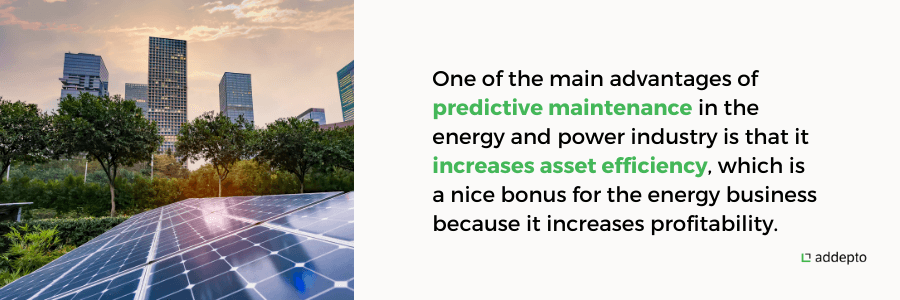
April 14, 2022
Machine Learning Predictive Maintenance and Prevention (update: 2024)
Author:

CSO & Co-Founder
Reading time:
8 minutes
Nowadays machine learning and AI simplify and improve numerous processes and things. Equipment maintenance is one of them. Today you could use predictive maintenance together with machine learning algorithms to prevent big losses and anomalies.
Does this sound interesting to you? Read our article: Machine Learning. What it is and why it is essential to business?
Predictive Maintenance: definition and importance
The technique we are talking about is called predictive maintenance[1]. This strategy implies monitoring the equipment’s condition, and then predicting the possibility of failure and preventing the problem by performing maintenance on time.

Some people think that implementing predictive maintenance is not really essential, but that’s not right. By minimizing the number of occurred failures, it can save your budget from expenses on unexpected maintenance. Apart from this, predictive maintenance is able to protect you and your business from undesired breaks because of equipment failure. You will simply solve the problems before they appear, which means that your equipment won’t need time-consuming repair.
Predictive and Preventive Maintenance: what’s the difference?
Setting up a maintenance calendar is the main difference between predictive and preventative maintenance.
The predictive maintenance calendar is based on equipment usage and time intervals, while preventive maintenance uses condition monitoring sensors and prediction algorithms to manage maintenance schedules.
How Predictive Maintenance works
Predictive maintenance involves a lot of approaches, but here are those of that are the most popular:
- Infrared thermography analysis — sensors monitor the temperature of equipment and, therefore, prevent overheating.
- Vibration analysis — this technique is used to detect imbalance, looseness, wear and other defects which can lead to problems with the maintenance.

- Current analysis — when measuring the current and voltage of electricity (usually supplied to a motor), it is also possible to detect problems with couplings, belts, etc.
- Ultrasonic analysis — changes in frequencies produced by an asset can serve as an indicator of a potential failure. Detected on time, they can help to notice leaking valves and other unpleasant issues.
- Oil analysis — logically, this approach is focused on the asset’s lubrication. Proper lubrication is crucial for the flawless performance of the equipment, and that’s why this technique is so popular.
Collect data from IoT sources for predictive maintenance with machine learning
However, it is not enough to decide what problems you want to prevent and choose the approach. In any case, you will also have to collect the data from equipment. That’s the most important thing to do here, and the Internet of Things (or IoT, if short) is a great way to deal with this challenge. Sensors and tools widely used in the IoT industry can be very useful when it comes to collecting and then sharing the data. They can connect all the pieces of equipment to a central hub. In turn, a central hub functions with the help of cloud technology. Other potential options include LAN and WLAN-based connectivity.

Connection between a central hub and all the available assets is a basis for predictive maintenance. The collected information can be used by technicians in order to analyze the condition of the equipment and make a decision if the maintenance is required. However, installing and setting up such a system is a rather complicated task. In case something is done wrong, the sensors will provide your team with the wrong data. As a result, the whole idea of predictive maintenance will be lost. So if you are not that experienced in the IoT sphere, we highly recommend you find an expert.
Predictive Maintenance using Machine Learning
Implementing predictive maintenance using big data is not easy. Actually, it is often hard to deal with large volumes of data, even if it has nothing to do with the maintenance. A human can simply make a mistake in the big data processing, miss something important and, therefore, make a wrong decision. Fortunately, this problem can be solved with data science services. Follow these steps:
1. Decide what pieces of equipment to look after
Obviously, the best option is to keep an eye on every single piece of equipment. But in case your budget for predictive maintenance implementation is limited, focus only on the most crucial ones. These include assets without which the production is impossible and those ones which have high repair costs.
2. Create a database
Again, a detailed and reliable database is a must. Ideally, it should answer the following questions:
- What kind of failures can take place?
- Which parts of the equipment can these failures affect?
- How much time can every failure process take? Will it be immediate or slow?
- What parameters can be measured about every part of the system (for instance, temperature)?
- What exactly can these parameters tell about the state of equipment?
- How often should these parameters be measured?
Collecting data and developing a database can be not that easy as assets don’t usually break often. For some of them, it may take years to wear out and finally fail. Fortunately, in most cases, the above-mentioned data should already be available, especially if you don’t use extremely unique equipment. And feel free to use analytics dashboards for monitoring — they can make your life significantly easier.

3. Establish the failure modes
Now, correlate the assets you chose with the collected data. Perform a detailed analysis, and identify the failure modes of every piece of equipment you want to “watch”.
4. Develop and test a model
Now it is time to create a predictive maintenance model. When working on it, decide on what results you expect the model to provide you with. Should it only inform you that something is about to go wrong or also take some measures? Or maybe this depends on every particular failure case? Be specific here, otherwise, your model won’t function properly. When the model is ready, don’t forget to test it.
5. Enjoy the results
This is the simplest step to take. In case you are satisfied with the test results, deploy your predictive maintenance model and start using it.
Predictive Maintenance applications across different industries
Predictive maintenance can be used in many industries and ways. For instance, it can help you to identify overloads in electrical panels, insulation breakdowns, dangerous temperature and pressure changes, amperage spikes, power imbalances, etc. In this way, it can be used in any business which requires participation of the machines. Manufacturing is among the most popular industries for predictive maintenance implementation. Those industries which are somehow related to vehicles (for example, aircraft) also tend to use predictive maintenance in order to keep potential failures under control.
Manufacturing Industry
According to a McKinsey report, predictive maintenance can reduce machine downtime by 30%-50%, and increase machine life by 20%-40%. Below you can find how your company can benefit from predictive maintenance technology:

- the use of vibration sensors to identify models of fragile milling machine spindles
- measuring the temperature difference before and after the heat exchanger to detect the first signs of clogging
- monitoring the temperature of the processor and the robot body, as well as positioning errors and overload, and using this data to analyze the robot’s condition
Oil and Gas Industry
The oil and gas industry was one of the first to introduce preventive maintenance. The instability of the oil market is one of the main reasons for the wider use of this technology. Examples of the use of preventive maintenance are below:
- Monitoring the condition of oil and gas pumps
- Maintenance and monitoring of oil and gas vessels
- Virtual drilling rig monitoring
- Tank pressure monitoring
- Enterprise performance monitoring
- Pipeline monitoring
- Drill corrosion detection and maintenance
Power and Energy Industry
One of the main advantages of predictive maintenance in the energy and power industry is that it increases asset efficiency, which is a nice bonus for the energy business because it increases profitability.

As in other industries, detecting problems and taking measures to eliminate them in advance guarantees that failures are unlikely. Predictive maintenance also protects the company from costly repairs.
Benefits of implementation
And a few more words about benefits. The most important competitive advantage of predictive maintenance and machine learning is reducing big losses in terms of funds and time — we talked about this at the beginning of the article. Obviously, you will have to spend a part of your budget on the system implementation, but the return on investment (or ROI, if short) is worth all the costs. For example, the US Department of Energy reports about 70-75% decrease in breakdowns, and that’s an impressive result.
Another important thing is energy saving. A malfunctioning asset may consume more electricity or any other resource like gas or water. But a predictive maintenance model can inform you about the changes in energy consumption, so you will be able to take action. And, again, that’s not only about energy efficiency but also about saving money. Unfortunately, energy is not free, but you can save a bit thanks to predictive maintenance.
Final thoughts about Predictive Maintenance
So, now you understand how important predictive maintenance is, how to use it together with machine learning and what benefits it can bring to you and your business.
However, in case you still have any questions, feel free to ask them. We are always glad to help you.
Also check out our machine learning consulting services to learn more.
References
[1] Wikipedia. Predictive maintenance. URL: https://en.wikipedia.org/wiki/Predictive_maintenance. Accessed Jun 5, 2019.
Category:





